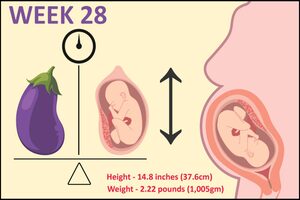The end of week 28 marks the beginning of the 8th month of pregnancy, and officially you have entered the third or final trimester of pregnancy. In the last week of the seventh month, the baby is about the size of an eggplant or brinjal. With the fetal nerve cells multiplying in millions, the senses of hearing, smell, vision, and touch are getting functional.
With skill enhancement of the baby- blinking and dreaming happening this week, the mom-to-be can have a ball with her growing belly only if she experiences no major back pain or sciatic pain.
The other pregnancy symptoms, baby growth, and things the mother-to-be will need to take care of are discussed in this write-up.
In this Article
Baby’s developments @ Week 28 of pregnancy
The baby at week 28 of pregnancy is nearly 37.6cm long weighing around 1000gms. The baby’s heart rate has been changing since week 5 or 6 of pregnancy (110 beats per minute), where it soars up to 170 beats per minute by week 7. This week, the heart rate slows down to 130 to 140 beats a minute. The small heart pumps quite the amount of blood more quickly.
At week 28, the developmental activities observed in the baby or fetus are:
Hiccups
The fetal hiccups can be felt as mild rhythmic twitches and visible as the belly moves like a jelly. Sometimes the baby’s hiccups can be throughout the day, while the ultrasound too can pick up the twitching movements.
Rapid eye movements
The rapid eye movements observed this week in the baby indicate that the baby is developing the ‘dream’ phase of sleep. The sleep cycle is getting regular with a pattern of sleep and wakefulness.
By week 28, though the baby’s developing process is still not complete, the baby is ready to come with a 90% chance of survival.
What are preterm babies?
The babies born between 28 to 37 weeks of pregnancy are called pre-term babies. However, the experts believe completion of a full term (more than 37 weeks) is essential.
A full-term born baby can take the benefit of a natural womb environment and nourishment while averting the risk of pregnancy complications.
Mom-to-be @ Week 28 of pregnancy
At week 28, the mothers-to-be officially enter into the third trimester of pregnancy. As the delivery time is close, the baby’s summersault, kicks, and other movements become more prominent and frequent.
Constant baby movements can keep the moms-to-be awake through the night and also keep you tired through the day. The expecting mothers can expect a few of the following symptoms this week.
- Back pain because of the growing tummy and weight,
- Sciatica pain– shooting pain, numbness, and tingling sensations starting from the lower back radiating down the back of the legs,
- Although skin throughout the pregnancy becomes sensitive, prone to rashes, spots, redness, and itching, the most sensitive skin spot is the belly,
- The skin gets sensitive to sunlight- causing a mask of pregnancy or melasma, detergents, chlorine, heat, chemicals, and more,
- Expanding belly exerts pressure on the blood vessels, reducing the blood flow to the brain and causing dizziness or faintness,
- Bloating and gas,
- The hormone relaxin relaxes the ligaments of the pelvis. As a result, the pelvic joints get unstable and painful called symphysis pubis dysfunction,
- Bleeding gums and stuffy noses can be difficult to breathe during nighttime due to the raging pregnancy hormones.
Also Read: https://pregajunction.com/blog/week-27-pregnancy-symptoms/
Things to consider at week 28 of pregnancy
From week 28, as you move into the third trimester, your visit to the doctor and prenatal check-ups will get more frequent. Tips to follow at week 28 of pregnancy are:
- Use calamine lotion and moisturizers to treat the skin of the redness, itchy, swollen, skin sensitivity symptoms.
- Try easing out food intake by having six small meals a day instead of three large ones, helping reduce bloating, gas, and indigestion problems.
- Treat the sciatica pain by using heating pads, soaking the feet in warm water, and taking ample bed rest with legs placed at elevated positions
- Have healthy, nutritious food, and pump up your fluid intake with juices and water to improve blood circulation.
- Use support belts for the pelvic region- to stabilize the ligaments and pelvic joints.
- Try weaning nasal strips to ease breathing while sleeping.
- Regular brushing of teeth, flossing, and cleaning the tongue can reduce the number of bacteria in the mouth.
- Try to stay in the shade when in the sun or apply sunscreen with SPF-30 or more. Check with your dermatologists or doctor the sunscreens that are safe during pregnancy.
Also Read: https://pregajunction.com/blog/types-of-baby-delivery-during-pregnancy/
Conclusion
At week 28, the baby is growing with its brain developing rapidly. Though the baby can rush out into the outer world anytime after week 28, it still needs to stay and fine-tune itself in the womb to adapt to the outside environment. The babies born on or after week 28 and before week 37 are called pre-term and may require additional neonatal care when out in the world. Connect with your doctor for more queries and regular prenatal tests and check-ups.
Reference
Overview | NHS




